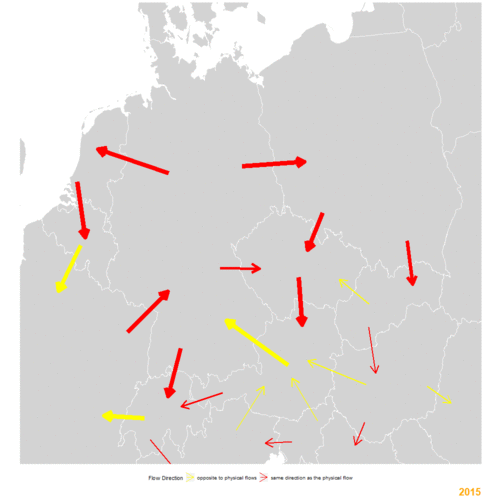Evolution of unscheduled flows in continental Europe: their lasting negative impact on electricity cross-border capacity

Evolution of unscheduled flows in continental Europe: their lasting negative impact on electricity cross-border capacity
What is it about?
The latest version of the ACER market monitoring report states that while the electricity wholesale markets continue to integrate across the EU, some significant challenges remain. The upcoming edition of the report will confirm that observation. In particular, the available cross border capacity remains insufficient, and this is partly due to important levels of unscheduled flows (UFs).
What are the unscheduled flows? Why are they relevant?
Discrepancies exist between the physical paths followed by power flows at a given moment in time and the paths anticipated from transactions triggering such flows. These discrepancies take the form of various “distortive” flows in the system, called unscheduled flows.
Transmission System Operators (TSOs) must anticipate the impact of unscheduled flows to ensure the integrity of the system. In doing so, they reduce the amount of capacity available for trade by the amount necessary to cope with unscheduled flows. As a consequence, unscheduled flows cause social welfare losses and hamper market integration.
What is ACER’s position?
ACER believes that improving the capacity calculation methodologies and the bidding zone configurations will mitigate the impact of unscheduled flows in the short term. In the longer term, loop flows will be alleviated by investments in the transmission network.
ACER has been monitoring the evolution of unscheduled flows in Europe since 2012. Specifically, ACER monitors unscheduled flows as the sum of unscheduled allocated flows and loop flows. Unscheduled allocated flows stem from insufficient coordination in capacity calculation and allocation processes. Loop flows within a bidding zone result from electricity exchanges inside other bidding zones [1].
What are the main findings?
In 2020, total unscheduled flows amounted to 111 TWh, which represents an overall increase of 2% compared to 2019. In particular, in the Core (excluding CWE) [2] region, unscheduled flows increased by almost 8% compared to 2019. Overall, this region had the larger share of UFs, more than 46% of all UFs in Europe. In the Core (CWE) region, unscheduled flows decreased by more than 5% year-on-year.
Main average oriented unscheduled flows in Continental Europe - 2015 to 2020
Source: ACER calculations based on ENTSO-E and Vulcanus data.
Note: The arrow is red when unscheduled flows are in the same direction as the physical flow, and yellow when they are opposite to physical flows. The width of the arrows is proportionate to the flows. For each year, the specific value of each flow in MW is detailed in the corresponding MMR edition.
The animation shows the prevailing direction of unscheduled flows from 2015 to 2020. An overall pattern through the years consists of two major loops, from Germany to Switzerland to the south west, and to Poland to the east.
Another significant pattern can be observed from the north to the south of Germany, via the Netherlands, Belgium and France. The animation shows that this pattern changed over the last two years. In particular, since 2019, the overall shift from coal to gas led to reduce the amount of electricity imported from Germany to the Netherlands while the amount of electricity exports from the Netherlands increased. This caused the level of unscheduled flows to decrease in the area.
For a complete analysis of the evolution of unscheduled flows in 2020, consult our publication.
The next edition of the ACER Market Monitoring Report (2020) will be published in November 2021.


